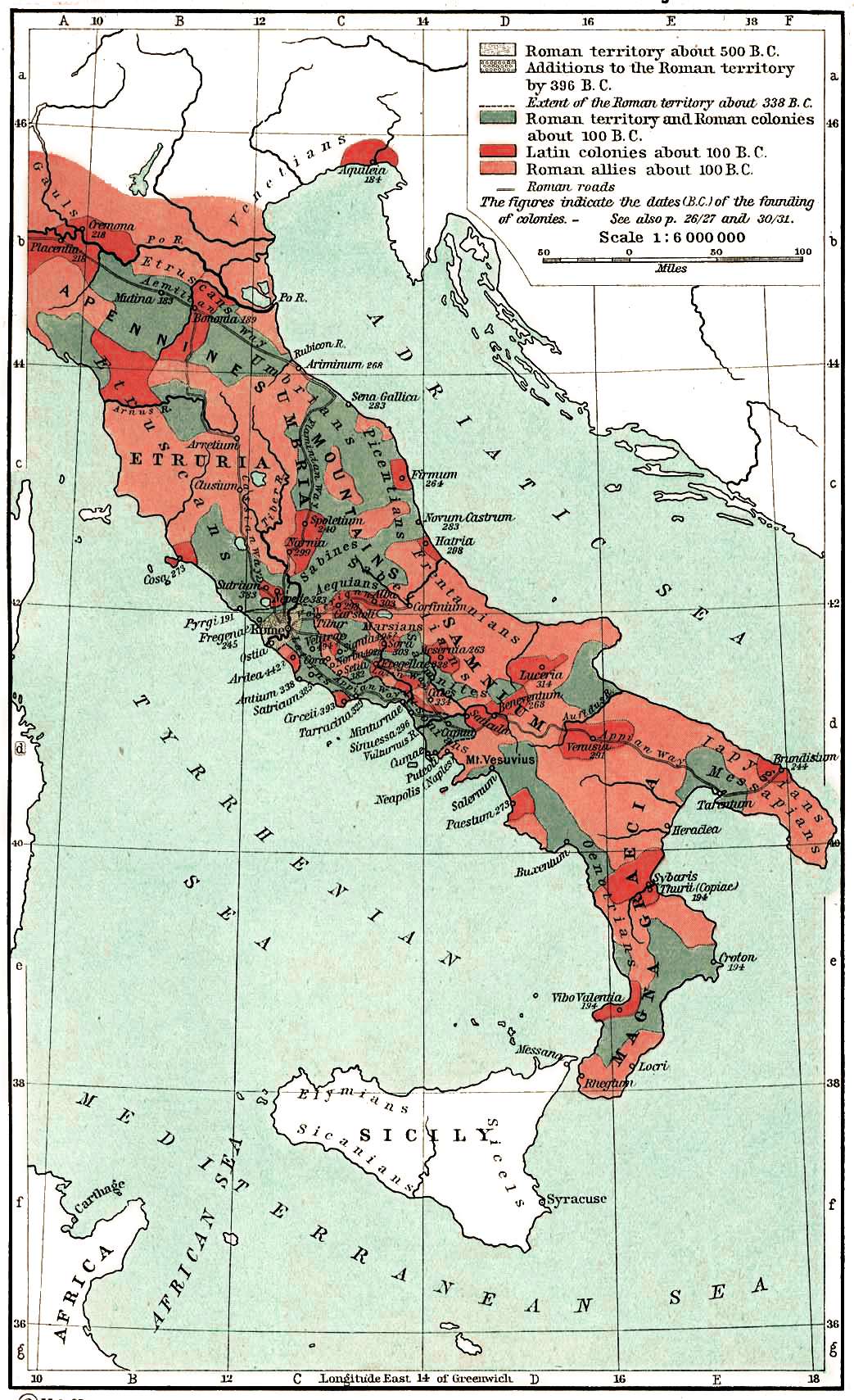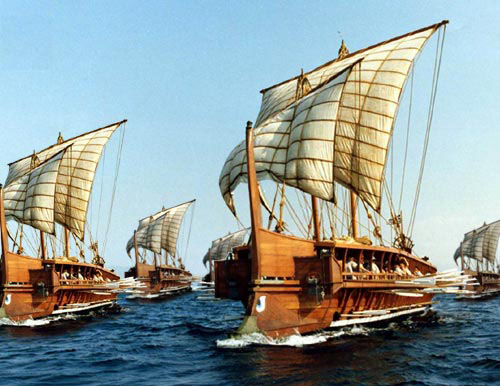|
Socii Navales
''Socii navales'' or "naval allies", were a class of the ''socii'' or ''foederati'' (allies) of Rome, that provided naval support. A large number of them were Greek cities in Sicily and mainland Greece. They were often used to augment the main fleet, often with lighter ships that the Romans or their adversaries had, such as triremes or pentekonters. The number of ships provided by the ''socii navales'' is disputed, with some saying that by 260 BC 42 ships were being supplied however others agree that by 210 BC only 12 were supplied, and that by 195 BC 25 ships were being supplied. The men provided by the ''socii navales'' were sailors and rowers. Known Socii Navales *Cumae Cumae ( grc, Κύμη, (Kumē) or or ; it, Cuma) was the first ancient Greek colony on the mainland of Italy, founded by settlers from Euboea in the 8th century BC and soon becoming one of the strongest colonies. It later became a rich Ro ... References {{Reflist Navy of ancient Rome Socii ... [...More Info...] [...Related Items...] OR: [Wikipedia] [Google] [Baidu] |
Socii
The ''socii'' ( in English) or ''foederati'' ( in English) were confederates of ancient Rome, Rome and formed one of the three legal denominations in Roman Italy (''Italia'') along with the Roman citizens (''Cives'') and the ''Latin Rights, Latini''. The ''Latini'', who were simultaneously special confederates (''Socii Latini'') and semi-citizens (''Cives Latini''), should not be equated with the homonymous Italic people of which Rome was part (the Latins (Italic tribe), Latins). This tripartite organisation lasted from the Roman expansion in Italy (509-264 BC) to the Social War (91–87 BC), when all peninsular inhabitants were awarded Roman citizenship. Treaties known as ''foedus'' served as the basic template for Rome's settlement with the large array of tribes and city-states of the whole Italian peninsula. The confederacy had its origin in the ''foedus Cassianum'' ("Treaty of Cassius", 493 BC) signed by the fledgling Roman republic with its neighbouring Latin city-states shor ... [...More Info...] [...Related Items...] OR: [Wikipedia] [Google] [Baidu] |
Foederati
''Foederati'' (, singular: ''foederatus'' ) were peoples and cities bound by a treaty, known as ''foedus'', with Rome. During the Roman Republic, the term identified the ''socii'', but during the Roman Empire, it was used to describe foreign states, client kingdoms or barbarian tribes to which the empire provided benefits in exchange for military assistance. The term was also used, especially under the empire, for groups of "barbarian" mercenaries of various sizes who were typically allowed to settle within the empire. Roman Republic In the early Roman Republic, ''foederati'' were tribes that were bound by a treaty (''foedus'' ) to come to the defence of Rome but were neither Roman colonies nor beneficiaries of Roman citizenship (''civitas''). Members of the Latini tribe were considered blood allies, but the rest were federates or ''socii''. The friction between the treaty obligations without the corresponding benefits of Romanity led to the Social War between the Romans, with a ... [...More Info...] [...Related Items...] OR: [Wikipedia] [Google] [Baidu] |
Ancient Rome
In modern historiography, ancient Rome refers to Roman civilisation from the founding of the city of Rome in the 8th century BC to the collapse of the Western Roman Empire in the 5th century AD. It encompasses the Roman Kingdom (753–509 BC), Roman Republic (509–27 BC) and Roman Empire (27 BC–476 AD) until the fall of the western empire. Ancient Rome began as an Italic settlement, traditionally dated to 753 BC, beside the River Tiber in the Italian Peninsula. The settlement grew into the city and polity of Rome, and came to control its neighbours through a combination of treaties and military strength. It eventually dominated the Italian Peninsula, assimilated the Greek culture of southern Italy ( Magna Grecia) and the Etruscan culture and acquired an Empire that took in much of Europe and the lands and peoples surrounding the Mediterranean Sea. It was among the largest empires in the ancient world, with an estimated 50 to 90 million inhabitants, roughly 20% of t ... [...More Info...] [...Related Items...] OR: [Wikipedia] [Google] [Baidu] |
Sicily
(man) it, Siciliana (woman) , population_note = , population_blank1_title = , population_blank1 = , demographics_type1 = Ethnicity , demographics1_footnotes = , demographics1_title1 = Sicilian , demographics1_info1 = 98% , demographics1_title2 = , demographics1_info2 = , demographics1_title3 = , demographics1_info3 = , timezone1 = CET , utc_offset1 = +1 , timezone1_DST = CEST , utc_offset1_DST = +2 , postal_code_type = , postal_code = , area_code_type = ISO 3166 code , area_code = IT-82 , blank_name_sec1 = GDP (nominal) , blank_info_sec1 = €89.2 billion (2018) , blank1_name_sec1 = GDP per capita , blank1_info_sec1 ... [...More Info...] [...Related Items...] OR: [Wikipedia] [Google] [Baidu] |
Triremes
A trireme( ; derived from Latin: ''trirēmis'' "with three banks of oars"; cf. Greek ''triērēs'', literally "three-rower") was an ancient navies and vessels, ancient vessel and a type of galley that was used by the ancient maritime civilizations of the Mediterranean Sea, especially the Phoenicians, ancient Greece, ancient Greeks and ancient Rome, Romans. The trireme derives its name from its three rows of oars, manned with one man per oar. The early trireme was a development of the penteconter (ship), penteconter, an ancient warship with a single row of 25 oars on each side (i.e., a single-banked boat), and of the bireme ( grc, διήρης, ''diērēs''), a warship with two banks of oars, of Phoenician origin. The word dieres does not appear until the Roman period. According to Morrison and Williams, "It must be assumed the term pentekontor covered the two-level type". As a ship, it was fast and agile and was the dominant warship in the Mediterranean from the 7th to the 4th ... [...More Info...] [...Related Items...] OR: [Wikipedia] [Google] [Baidu] |
Pentekonters
The penteconter (alt. spelling pentekonter, pentaconter, pentecontor or pentekontor; el, πεντηκόντερος, ''pentēkónteros'', "fifty-oared"), plural penteconters, was an ancient Greek galley in use since the archaic period. In an alternative meaning, the term was also used for a military commander of fifty men in ancient Greece. History The penteconters emerged in an era when there was no distinction between merchant ships and warships. They were versatile, long-range ships used for sea trade, piracy and warfare, capable of transporting freight or troops. A penteconter was rowed by fifty oarsmen, arranged in a row of twenty-five on each side of the ship. A midship mast with sail could also propel the ship under favourable wind. Penteconters were long and sharp-keeled ships, hence described as ''long vessels'' (, ''nḗes makraí'' ). They typically lacked a full deck, and thus were also called ''unfenced vessels'' (, ''áphraktoi nḗes''). Homer describes war s ... [...More Info...] [...Related Items...] OR: [Wikipedia] [Google] [Baidu] |
Cumae
Cumae ( grc, Κύμη, (Kumē) or or ; it, Cuma) was the first ancient Greek colony on the mainland of Italy, founded by settlers from Euboea in the 8th century BC and soon becoming one of the strongest colonies. It later became a rich Roman city, the remains of which lie near the modern village of Cuma, a ''frazione'' of the ''comune'' Bacoli and Pozzuoli in the Metropolitan City of Naples, Campania, Italy. The archaeological museum of the Campi Flegrei in the Aragonese castle contains many finds from Cumae. History Early The oldest archaeological finds by Emil Stevens in 1896 date to 900–850 BCE and more recent excavations have revealed a Bronze Age settlement of the ‘pit-culture’ people, and later dwellings of Iron Age Italic people, Italic peoples whom the Greeks referred to by the names Ausones and Opici (whose land was called :it:Opicia, Opicia). The Greek settlement was founded in the 8th century BCE by emigrants from cities of Eretria and Chal ... [...More Info...] [...Related Items...] OR: [Wikipedia] [Google] [Baidu] |
Navy Of Ancient Rome
A navy, naval force, or maritime force is the branch of a nation's armed forces principally designated for naval warfare, naval and amphibious warfare; namely, lake-borne, riverine, littoral zone, littoral, or ocean-borne combat operations and related functions. It includes anything conducted by surface Naval ship, ships, amphibious warfare, amphibious ships, submarines, and seaborne naval aviation, aviation, as well as ancillary support, communications, training, and other fields. The strategic offensive role of a navy is Power projection, projection of force into areas beyond a country's shores (for example, to protect Sea lane, sea-lanes, deter or confront piracy, ferry troops, or attack other navies, ports, or shore installations). The strategic defensive purpose of a navy is to frustrate seaborne projection-of-force by enemies. The strategic task of the navy also may incorporate nuclear deterrence by use of submarine-launched ballistic missiles. Naval operations can be broa ... [...More Info...] [...Related Items...] OR: [Wikipedia] [Google] [Baidu] |





